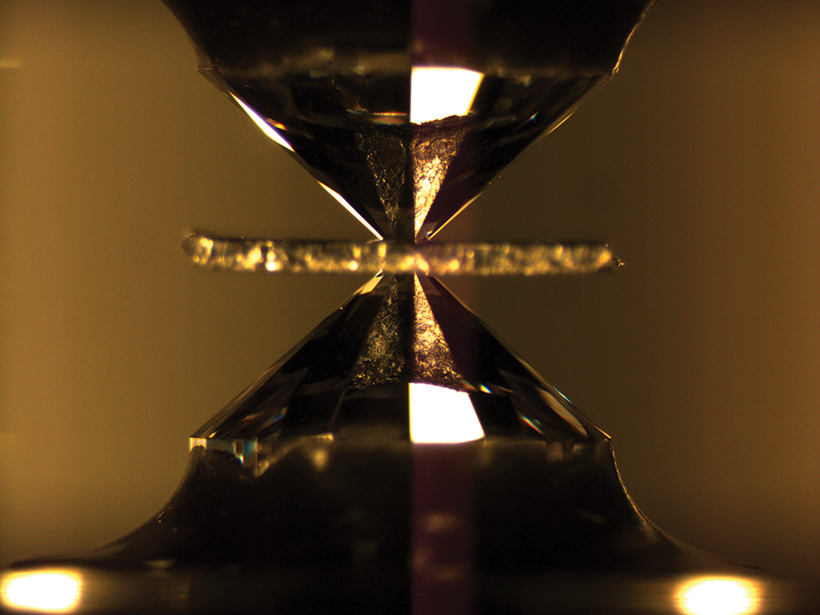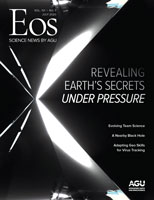Two giant earthquakes in the 1960s—one in Chile (1960) and one in Alaska (1964)—generated free oscillations of the entire planet and provided important new seismic data that were incorporated into improved velocity and density models of Earth’s interior [e.g., Dziewonski and Anderson, 1981; Kennett et al., 1995]. To interpret what these velocity and density models revealed about the composition and mineralogy beneath the surface—and to address other, related questions in Earth science—new experiments involving Earth materials at high pressures and temperatures were needed. Efforts to facilitate these experiments led to innovations in instrumentation—such as diamond anvil cells and large-volume presses [e.g., Bassett, 2009; Liebermann, 2011], which could produce pressures and temperatures representative of the deep Earth—and helped spur the emergence of mineral physics as a distinct discipline with the geosciences.
The term mineral physics was coined by Orson Anderson when he established his experimental lab at Columbia University’s Lamont Geological Observatory in 1964 [Liebermann, 2019a]. Now the discipline is widely considered one of three pillars of geophysics, along with geodynamics and seismology. Geophysics as a whole advances by close cooperation among researchers in these fields. The role of mineral physicists is to investigate properties of minerals, knowledge of which is essential to interpreting seismic data accurately and running realistic geodynamic simulations. To be useful in such applications, mineral properties must be studied over the wide range of pressures, temperatures, and chemical compositions seen in the interior of Earth (or, for some researchers, in the interiors of other terrestrial planets), but these materials and conditions present several challenges.

Today scientists are tackling these challenges through a combination of experimental and computational methods. Experiments typically offer more precise information at lower pressures and temperatures, whereas computational work offers more detailed information at conditions more challenging to re-create in experiments. Although studying bulk material properties is vital to understanding planetary behavior, atomistic inspection of these complex materials is necessary to understand why they behave the way they do. A connection is thus established between atomic- and planetary-scale phenomena, which mineral physicists are in a unique position to illuminate [Wentzcovitch and Stixrude, 2010].
Mineral Physics Finds Its Place at AGU
Through the 1970s, the mineral physics community began organizing an initiative to establish a formal role at AGU. At Spring Meeting 1982 in Philadelphia, a small group of researchers met for lunch to develop a proposal for AGU recognition. In response to the proposal, in 1983 the AGU Executive Council approved the establishment of an All-Union Committee on Mineral Physics. Among others who assumed early leadership roles, Anderson was the founding chair, and I served as the committee’s first foreign secretary, a role in which I cultivated connections with mineral physics laboratories throughout the world.
Mineral physics is a diverse field that includes the study of crystal structures, thermochemical properties, physical properties, equations of state, and phase equilibria of minerals and their chemical analogue compounds. These parameters are all interrelated, yet for much of the 20th century they were traditionally studied and reported by researchers in disparate fields who represented different AGU sections. Studies of equations of state and elastic constants, for example, were usually included under Tectonophysics, whereas studies of magnetic mineral properties fell under Geomagnetism and Paleomagnetism, and crystal structure and phase equilibria studies appeared under Volcanology, Geochemistry, and Petrology. The extent of this issue was highlighted during AGU’s Spring Meeting 1983, when discussions about silicate mineralogy and petrology were held concurrently in seven different sessions sponsored by five different sections.
The mineral physics community sponsored many conferences and workshops beginning in the 1980s. These meetings clearly marked the emergence of mineral physics into the mainstream of geophysics.
It was apparent that experimental and theoretical investigations into the relationship between interatomic forces and physical properties of minerals were central to current problems in the Earth sciences, such as whether the upper and lower mantles are chemically distinct. But research efforts were fragmented, with little coordination or cooperation among researchers with different backgrounds and objectives.
To address this situation, the mineral physics community sponsored many conferences and workshops beginning in the 1980s [e.g., Schock, 1985; Navrotsky and Weidner, 1989; Ahrens et al., 1989]. From these workshops, it became evident that new scientific advances would provide dramatic progress in our understanding of Earth’s interior. These meetings clearly marked the emergence of the discipline of mineral physics into the mainstream of geophysics.
Several workshops focused, for example, on the importance of emerging synchrotron X-ray sources in enabling high-pressure experiments at the national laboratories of the U.S. Department of Energy and the Cornell High Energy Synchrotron Source supported by the National Science Foundation [Bassett et al., 1988; Smith and Manghnani, 1988; Sutton et al., 1988]. As Bill Bassett told me while I was preparing this article, “These synchrotron facilities quickly became the focus of many mineral physics experiments; X-ray diffraction patterns at high pressures and temperatures could be obtained every few seconds rather than [taking] a week.” A camera added to the instrumentation soon allowed correlation of visual observations of changes in mineral properties with the diffraction changes. The camera also made it possible to aim the X-ray beam at specific portions of a sample “and thus watch phase transitions and reactions proceed step by step,” according to Bassett. Real-time X-ray imaging allowed observation of strained portions of minerals surrounding inclusions and other internal structures, and reactions between solids and fluids could also be studied.
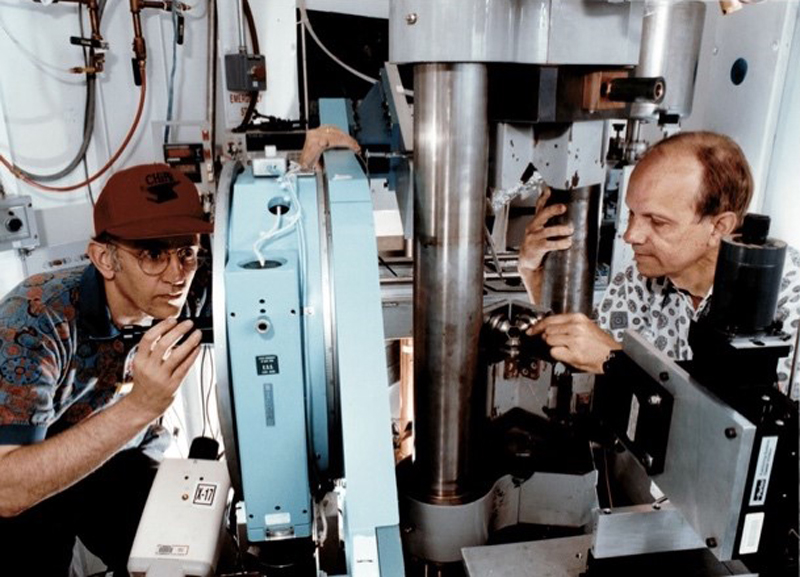
Numerous important findings emerged from early applications of synchrotron radiation in mineral physics, including the proposal that phase transitions in olivine are the origin of deep-focus earthquakes [Furnish and Bassett, 1983].
Pioneers in Rock Deformation
If Francis Birch, who described the chiefly silicate mineralogy of Earth’s mantle in a seminal paper [Birch, 1952], is recognized as the “father of mineral physics” [Liebermann, 2019a], then David Griggs is rightly called the “father of experimental rock deformation,” according to Terry Tullis, who cited Griggs’s [1936] Journal of Geology paper “Deformation of rocks under high confining pressures” in his tribute to Griggs at AGU’s Fall Meeting 2019. Griggs, who developed a widely used high-pressure apparatus known as the Griggs rig, and Birch were students of renowned physicist (and posthumous namesake of bridgmanite, Earth’s most abundant mineral) Percy Bridgman at Harvard; as Brian Evans of the Massachusetts Institute of Technology (MIT) has noted, both Bridgman and Birch also contributed to rock mechanics, via their own work and through their influence on Griggs and on Bill Brace. Griggs, at the University of California, Los Angeles, and Brace, at MIT, nurtured the careers of many students in rock mechanics using a variety of experimental apparatuses.
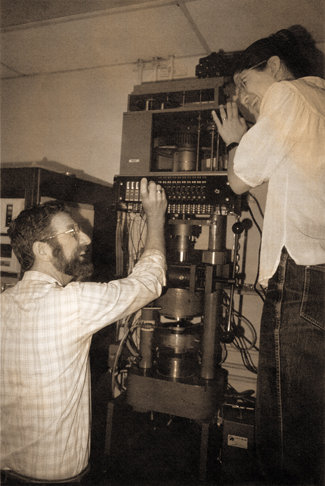
I recall a time at a Gordon Conference in the late 1960s or early 1970s at Kimball Union Academy in New Hampshire when some of us young scientists were sitting outside a cottage listening to Griggs and Brace discuss the current state and future of rock deformation research in the United States. For young graduate students and postdocs, it was an exhilarating experience to be in the presence of such “giants” in the field, but it was also a chance to see firsthand how scientific leaders could relate and convey their visions of a discipline, notwithstanding the fact that they were in competition for some of the same bright young minds.
Prompted by the earlier formation of the mineral physics group and by the realization that researchers studying rock mechanics were failing to connect with the larger membership of AGU, many students of Brace and Griggs, now leaders in the field, met one year in the early 1990s on the steps outside the conference center in San Francisco, where the AGU Fall Meeting was being held, to discuss establishing a new AGU focus group. At Brian Evans’s suggestion, the committee formed by this group was named Physical Properties of Earth Materials (PPEM). The motivation for creating the new committee “was the fact that the physical behavior of the Earth owes to a system of materials, including not just minerals or rocks, but other noncrystalline solids and liquids,” Brian told me recently. Because of interactions among these various materials’ properties—such as elastic and inelastic behavior, electrical and fluid transport properties, and a host of behaviors during chemical reactions—“the behavior of the system may be quite different from a simple sum of the behavior of the components.” This is now a well-accepted idea.
A Growing Field
In 1993, soon after the formation of the PPEM committee, Steve Kirby from the U.S. Geological Survey’s Earthquake Hazards Program and I orchestrated a merger of the two focus groups and, after an arm-wrestling contest over what to name the newly conjoined group, selected the name Mineral and Rock Physics to give both disciplines more strength and visibility within AGU.
The combined focus group evolved to become a full-fledged and flourishing section of AGU in the early 2000s, and over the ensuing decades, high-impact research in the field has continued unabated. For example, experiments on artificially produced minerals at the high pressures and temperatures at which they are stable—conducted using ultrasonic interferometry [Li and Liebermann, 2014] and Brillouin spectroscopy [Speziale et al., 2014]—yielded new data on densities and seismic velocities for minerals at pressures into the lower mantle. And theoreticians have had increasing success in explaining the physical properties of minerals using fundamental principles; Wentzcovitch and Stixrude [2010] provide an excellent summary of the state of the art in theoretical and computational methods in mineral physics and applications to geophysics.
Although the members of the Mineral and Rock Physics section constitute only about 1% of the total AGU membership, they exert a disproportionate influence because mineral and rock physics is intimately connected to many other geoscience disciplines, including seismology, planetary science, petrology, geochemistry, geomagnetism, geodynamics, and even materials and climate science (Figure 1).
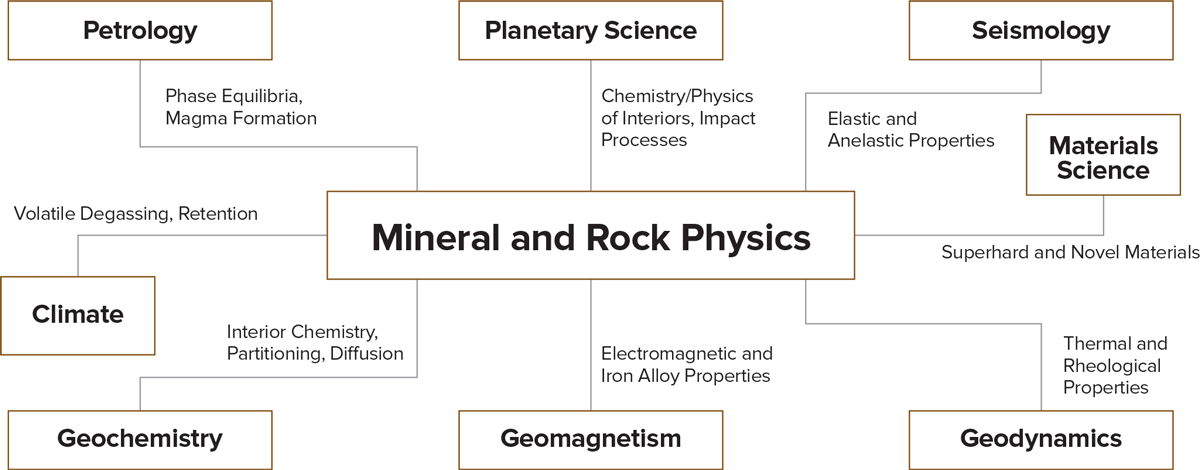
A good illustration of this interrelationship involves the experimental discovery by Murakami et al. [2004] of the postperovskite phase of bridgmanite (MgSiO3) coupled with its theoretical verification by Tsuchiya et al. [2004]. These two developments offered a possible explanation of the puzzling Dʺ region at the base of the lower mantle, where seismic velocities increase more slowly with depth, and spawned an explosion of communication between geodynamicists, seismologists, and mineral and rock physicists. Even if the perovskite-to-postperovskite phase transition hypothesized in 2004 is not the explanation for the Dʺ layer, this enhanced communication was a desirable outcome.
The growth and vitality of mineral and rock physics as a discipline are perhaps best illustrated by the number of scientists who have been involved in experimental and theoretical research.
The growth and vitality of mineral and rock physics as a discipline are perhaps best illustrated by the number of scientists who have been involved in experimental and theoretical research. With the assistance of many colleagues, I assembled informal tabulations documenting the large increase in the number of scientists in mineral and rock physics who held academic faculty appointments in U.S. universities in the 1960s and the 2010s. Whereas in the 1960s there were mineral physics faculty in 10 laboratories at 9 universities, in the 2010s there were faculty in 62 laboratories at 35 universities. Similarly, whereas there were rock mechanics faculty in 7 laboratories at 6 universities in the 1960s, there were faculty in 38 laboratories at 22 universities in the 2010s. A related and significant development has been the emergence of many women now directing laboratories: In the 1960s, no mineral physics or rock mechanics laboratories were directed by women, whereas in the 2010s, women headed 29% of mineral physics labs and 27% of rock mechanics labs. Anecdotally, similar trends of growth have occurred in nonacademic institutions in the United States and in international institutions (although accurately tabulating those scientists is more difficult), as well as in populations of students and other researchers in these fields.
Today the Mineral and Rock Physics section of AGU sponsors awards for graduate students and early-career researchers to recognize outstanding contributions by promising young scientists engaging in experimental and/or theoretical studies of minerals and other Earth materials. It is these researchers who will build on what has been accomplished in mineral and rock physics in the past half century and who will continue unraveling the physics and chemistry that govern how the solid Earth works.
Acknowledgments
It is a pleasure to acknowledge the many colleagues in mineral physics and rock mechanics who contributed to this article, including Jay Bass, Bill Bassett, Mike Brown, Pam Burnley, Tom Duffy, Bill Durham, Brian Evans, Steve Kirby, Dave Kohlstedt, Andy Kronenberg, Sebastien Merkel, Alex Navrotsky, Bob Schock, Terry Tullis, Quentin Williams, Renata Wentzcovitch, Jin Zhang, and Wenlu Zhu. I am also grateful to Quentin Williams for modifying the Williams-Lattimore diagram. I thank Tom Duffy and Brian Evans for their review of an earlier draft of this article.
References
Ahrens, T. J., et al. (1989), Frontiers in mineral physics: Report of the Mineral Physics Committee of the AGU, AGU, Washington, D.C.
Bassett, W. A. (2009), Diamond anvil cell, 50th birthday, High Pressure Res., 29(2), 165–186, https://doi.org/10.1080/08957950802597239.
Bassett, W. A., et al. (1988), Synchrotron radiation, applications in the Earth sciences, Eos Trans. AGU, 69(52), 1,675–1,676, https://doi.org/10.1029/88EO01260.
Birch, F. (1952), Elasticity and constitution of the Earth’s interior, J. Geophys. Res., 57, 227– 286, https://doi.org/10.1029/JZ057i002p00227.
Dziewonski, A. M., and D. L. Anderson (1981), Preliminary reference Earth model, Phys. Earth Planet. Inter., 25, 297–356, https://doi.org/10.1016/0031-9201(81)90046-7.
Furnish, M. D., and W. A. Bassett (1983), Investigation of the mechanism of the olivine-spinel transition in fayalite by synchrotron radiation, J. Geophys. Res., 88, 10,333–10,341, https://doi.org/10.1029/JB088iB12p10333.
Griggs, D. T. (1936), Deformation of rocks under high confining pressures: I. Experiments at room temperature, J. Geol., 44(5), 541–577, https://doi.org/10.1086/624455.
Kennett, B. L. N., E. R. Engdahl, and R. Buland (1995), Constraints on seismic velocities in the Earth from traveltimes, Geophys. J. Int., 122, 108–124, https://doi.org/10.1111/j.1365-246X.1995.tb03540.x.
Li, B., and R. C. Liebermann (2014), Study of the Earth’s interior using measurements of sound velocities in minerals by ultrasonic interferometry, Phys. Earth Planet. Inter., 233, 135–153, https://doi.org/10.1016/j.pepi.2014.05.006.
Liebermann, R. C. (2011), Multi-anvil, high-pressure apparatus: A half century of development and progress, High Pressure Res., 31, 493–532, https://doi.org/10.1080/08957959.2011.618698.
Liebermann, R. C. (2019a), The Orson Anderson era of mineral physics at Lamont in the 1960s, Minerals, 9(6), 342, https://doi.org/10.3390/min9060342.
Liebermann, R. C. (2019b), My Career as a Mineral Physicist at Stony Brook: 1976–2019, Minerals, 9(12), 761, https://doi.org/10.3390/min9120761.
Murakami, M. K., et al. (2004), Post-perovskite phase transition in MgSiO3, Science, 304, 855–858, https://doi.org/10.1126/science.1095932.
Navrotsky, A., and D. J. Weidner (Eds.) (1989), Perovskite: A Structure of Great Interest to Geophysics and Materials Science, Geophys. Monogr. Ser., vol. 45, AGU, Washington, D.C., https://doi.org/10.1029/GM045.
Schock, R. N. (Ed.) (1985), Point Defects in Minerals, Geophys. Monogr. Ser., vol. 31, AGU, Washington, D.C., https://doi.org/10.1029/GM031.
Smith, J. V., and M. H. Manghnani (1988), Synchrotron X-ray sources and the new opportunities in the Earth sciences: Workshop report, Rep. ANL/APS-TM-3, Argonne Natl. Lab., Lemont, Ill.
Speziale, S., H. Marquardt, and T. S. Duffy (2014), Brillouin scattering and its application in geosciences, Rev. Mineral. Geochem., 78, 543–603, https://doi.org/10.2138/rmg.2014.78.14.
Sutton, S. R., et al. (1988), Synchrotron X ray sources in the Earth sciences, Eos Trans. AGU, 69(52), 1,666–1,675, https://doi.org/10.1029/88EO01258.
Tsuchiya, T., et al. (2004), Phase transition in MgSiO3 perovskite in the Earth’s lower mantle, Earth Planet. Sci. Lett., 224, 241–248, https://doi.org/10.1016/j.epsl.2004.05.017.
Wentzcovitch, R., and L. Stixrude (Eds.) (2010), Theoretical and Computational Methods in Mineral Physics: Geophysical Applications, Rev. Mineral. Geochem. Ser., vol. 71, xvii + 484 pp., Mineral. Soc. of Am., Chantilly, Va., https://doi.org/10.1515/9781501508448.
Author Information
Robert Cooper Liebermann ([email protected]), Department of Geosciences and Mineral Physics Institute, Stony Brook University, Stony Brook, N.Y.
Acknowledgments
Eos thanks our science adviser Sébastien Merkel, Mineral and Rock Physics, for helping to develop our July Special Topic on High-Pressure, High-Temperature Experiments, which includes this article.
Citation:
Liebermann, R. C. (2020), Reflecting on a half century of mineral and rock physics at AGU, Eos, 101, https://doi.org/10.1029/2020EO145527. Published on 24 June 2020.
Text © 2020. The authors. CC BY-NC-ND 3.0
Except where otherwise noted, images are subject to copyright. Any reuse without express permission from the copyright owner is prohibited.

